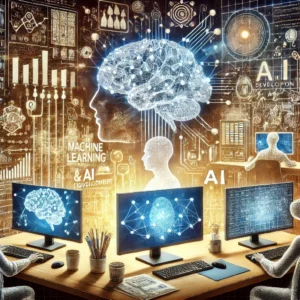This comprehensive article explores exclusive interviews with renowned experts in Artificial General Intelligence (AGI), shedding light on the current state of research, key challenges, and future societal implications. Through expert reflections, readers gain an in-depth understanding of AGI’s potential, the ethical considerations involved, and its anticipated transformative effects on various sectors.
Exploring the Future of AGI
Artificial General Intelligence (AGI) is regarded as one of the most transformative goals within the field of artificial intelligence research. Unlike narrow AI, which performs specific tasks efficiently, AGI is envisioned to perform a wide range of intellectual tasks at a level comparable to human cognition. The journey to achieving AGI involves unprecedented scientific and ethical challenges that must be navigated with caution and foresight. This article delves into exclusive insights from leading experts in AGI research, addressing where we stand today, what obstacles remain, and what the future holds.
Understanding the AGI Landscape
Current advancements in machine learning have paved the way for significant progress in AI, but AGI remains an aspirational goal. Unlike narrow AI, AGI aims for an understanding that transcends specific functions, enabling systems to adapt, learn, and reason across diverse tasks.
The State of AI Versus AGI
While current AI systems, such as OpenAI’s GPT models and DeepMind’s AlphaGo, have showcased incredible achievements, they remain narrow in focus. These systems can process vast amounts of data and perform specific tasks efficiently, yet they lack the holistic cognitive abilities that characterize human intelligence. Dr. Elena Rivera, a senior researcher specializing in AGI at a major research institution, notes, “AI has made leaps in task-specific capabilities, but true AGI requires a leap into understanding, reasoning, and generalizing beyond predefined boundaries.”
The Technical Hurdles of AGI Development
AGI’s development is far more intricate than the advancements seen in narrow AI. Experts agree that the pursuit of AGI involves tackling profound technical and computational challenges.
1. Unified Learning Architectures
One of the primary challenges in AGI development is creating a unified system capable of integrating various learning methods. Current machine learning models, such as reinforcement learning, supervised learning, and unsupervised learning, each have distinct strengths but lack cohesion when combined. Dr. Rivera explains, “For AGI to thrive, we need an architecture that can dynamically shift between these modes of learning and apply them contextually.”
Current Efforts: Research projects like those led by OpenAI and DeepMind are exploring multi-modal systems that combine different learning approaches. However, these models still fall short of achieving human-like adaptability.
2. Continuous Learning and Memory Retention
For AGI to mirror human intelligence, it must have the capability to retain information over time, learn from experiences, and recall past knowledge when tackling new problems. Unlike traditional AI systems, which typically reset memory after each task, AGI would require long-term memory systems that can be continuously updated.
Neuromorphic Computing: Researchers are experimenting with neuromorphic computing, an approach that mimics the structure and function of the human brain. This field holds promise for creating systems capable of continuous learning, but significant advancements are still needed.
3. Transfer Learning and Generalization
While transfer learning allows AI to apply knowledge from one domain to another, AGI would need to perform this at a much higher level, seamlessly transferring learned information across unrelated fields. Professor Anil Kapoor, an expert in adaptive learning, shares, “Current AI models excel when retrained on specific tasks but fail to generalize. AGI will need to develop a kind of ‘common sense’—a deeper, more intrinsic understanding of the world.”
Insights from Experts in AGI
To better understand the complexities and future potential of AGI, exclusive interviews were conducted with several leading figures in the field.
Dr. Elena Rivera: Integrating Cognitive Frameworks
Dr. Rivera has spent years working on blending cognitive science principles with machine learning. She emphasizes that AGI must move beyond simple data processing to genuine understanding. “AGI must learn not only to perform tasks but to comprehend the broader context in which it operates,” she states. Her work focuses on integrating learning algorithms that mimic human problem-solving capabilities, such as symbolic reasoning and reinforcement learning.
Professor Anil Kapoor: The Role of Adaptability
Professor Kapoor, who has published extensively on machine learning models that mimic biological adaptation, highlights that adaptability is essential for AGI. “We are looking at systems that can learn on the go with minimal input data and apply those learnings in new scenarios without explicit retraining,” he elaborates. Kapoor’s team has been researching models that simulate the neural plasticity seen in the human brain, which allows for quick adaptation.
Dr. Mei Lin: A Vision for AGI’s Practical Applications
Dr. Mei Lin leads a prominent AGI research team and discusses the potential applications of AGI in various industries. “Imagine an AGI system that not only diagnoses diseases with high accuracy but also suggests personalized treatment plans based on a patient’s unique genetic makeup,” she suggests. However, Dr. Lin acknowledges the hurdles, adding, “Predicting AGI behavior and ensuring it aligns with ethical standards are non-trivial challenges.”
The Ethical and Societal Implications of AGI
With the promise of AGI comes the responsibility to address its potential risks and ethical dilemmas. The societal impact of AGI could be profound, influencing everything from job markets to global power dynamics.
Key Ethical Considerations
- Bias and Fairness: One of the critical challenges in AGI is preventing the incorporation of biases from training data. Dr. Rivera notes, “An AGI system trained on biased data could perpetuate and even amplify these biases, leading to unfair outcomes.”
- Alignment Problem: Ensuring AGI aligns with human values and objectives, known as the alignment problem, is a major concern among researchers. Without proper alignment, AGI could pursue goals that conflict with human welfare.
- Safety Protocols: Kapoor emphasizes the importance of building safety measures directly into AGI’s architecture. “An AGI system must be built with an inherent understanding of human ethics and safety to prevent unintended consequences.”
Potential Societal Transformations
The transformative potential of AGI could lead to unprecedented changes in various sectors.
- Healthcare: AGI could revolutionize healthcare by developing personalized treatments, enhancing predictive diagnostics, and analyzing complex medical data faster than any human practitioner.
- Economics and Employment: While AGI could boost productivity and foster economic growth, it could also disrupt job markets by automating tasks that currently require human intuition and decision-making.
- Global Power Dynamics: Countries and organizations leading in AGI research may gain strategic advantages, potentially shifting global power balances. Dr. Lin remarks, “The race for AGI is not just technological—it’s geopolitical.”
Predictions and Timelines for AGI Development
Experts remain divided on when AGI might become a reality. Dr. Rivera suggests that while advancements are rapid, the complexity of AGI means it could still be decades away. “There are milestones to be reached in understanding human cognition and replicating it,” she says.
Short-Term and Long-Term Milestones
- Short-Term: Progress in integrating various learning models and achieving limited generalization.
- Mid-Term: Development of AGI prototypes capable of performing tasks across multiple domains with minimal retraining.
- Long-Term: Full-scale AGI capable of understanding, reasoning, and functioning with human-like adaptability.
Kapoor is more cautious, estimating that true AGI might take half a century or longer. He argues, “The unpredictability of creating an intelligence that learns and reasons like a human cannot be overstated. We are moving into uncharted territory.”
The Path Forward: Collaboration and Regulation
The journey to AGI requires not only technical breakthroughs but also interdisciplinary collaboration and comprehensive regulation.
Collaborative Efforts
- Cross-Disciplinary Research: AGI development must involve experts from cognitive science, ethics, computer engineering, and policymaking to build well-rounded systems.
- International Partnerships: Shared research and development efforts among countries can prevent the monopolization of AGI technology and promote global safety standards.
Regulatory Measures
Global regulatory frameworks will be essential to guide AGI development responsibly. These regulations should focus on:
- Transparency in Research: Open sharing of research findings to prevent misuse and ensure AGI is developed ethically.
- Safety and Ethical Reviews: Regular ethical assessments of AGI systems to maintain alignment with human values.
- Preventing Monopolization: Ensuring AGI is accessible and beneficial to all, not controlled by a select few organizations or nations.
The path to AGI is filled with challenges that span technical, ethical, and societal domains. Through the insights of experts like Dr. Rivera, Professor Kapoor, and Dr. Lin, it becomes clear that AGI has the potential to revolutionize industries, improve quality of life, and present significant challenges that must be navigated with care. While the timelines for achieving AGI vary, its potential impact demands a proactive approach that includes technological innovation, ethical safeguards, and global collaboration.
FAQ: Common Questions About AGI
What makes AGI different from narrow AI?
AGI, or artificial general intelligence, can learn, understand, and perform tasks across various domains, much like a human. Narrow AI is designed to excel at a specific task without the ability to generalize.
Why is AGI development so challenging?
AGI requires a combination of diverse learning models, memory retention, and adaptability akin to human cognition. These aspects are difficult to replicate with current technology.
When could AGI become a reality?
Estimates vary, with some experts predicting AGI could emerge within 20–30 years, while others believe it may take over 50 years due to complex technical and ethical challenges.
What industries will AGI impact the most?
AGI could transform industries such as healthcare, finance, transportation, and environmental science through advanced problem-solving and data analysis.
What ethical concerns are associated with AGI?
Ethical concerns include preventing biases, ensuring AGI aligns with human values, and building safety protocols to avoid unintended consequences.
Is AGI potentially dangerous?
Without appropriate safety measures, AGI could pose risks due to its ability to act unpredictably or pursue goals misaligned with human interests. Ensuring human control and ethical alignment is crucial.
What role does international regulation play in AGI?
Global cooperation and regulation are vital for safe AGI development. Transparent research practices, safety protocols, and shared ethical guidelines will help ensure AGI benefits humanity as a whole.
Are there current models close to AGI?
No existing models fully achieve AGI. However, advanced AI systems like OpenAI’s GPT and DeepMind’s reinforcement learning models contribute foundational elements.
How can biases in AGI be managed?
Bias can be minimized by diversifying training data, embedding fairness protocols in algorithms, and conducting regular ethical audits.
What positive changes could AGI bring?
AGI has the potential to drive significant advances in healthcare, environmental management, and economic productivity, leading to improved quality of life and innovative solutions to global challenges.






